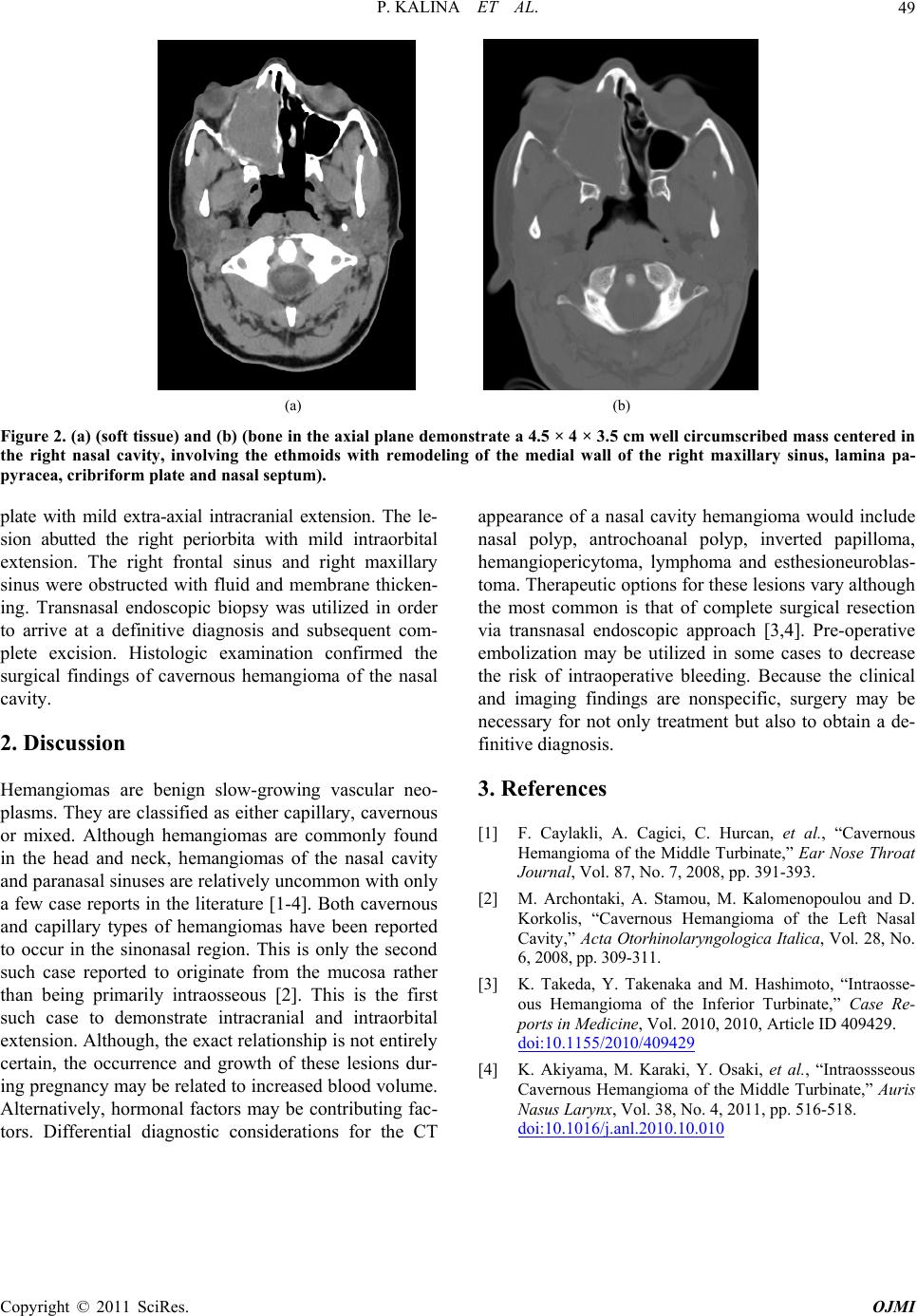
P. KALINA ET AL.49
(a) (b)
Figure 2. (a) (soft tissue) and (b) (bone in the axial plane demonstrate a 4.5 × 4 × 3.5 cm well circumscribed mass centered in
the right nasal cavity, involving the ethmoids with remodeling of the medial wall of the right maxillary sinus, lamina pa-
pyracea, cribri for m plate and nasal se ptum).
plate with mild extra-axial intracranial extension. The le-
sion abutted the right periorbita with mild intraorbital
extension. The right frontal sinus and right maxillary
sinus were obstructed with fluid and membrane thicken-
ing. Transnasal endoscopic biopsy was utilized in order
to arrive at a definitive diagnosis and subsequent com-
plete excision. Histologic examination confirmed the
surgical findings of cavernous hemangioma of the nasal
cavity.
2. Discussion
Hemangiomas are benign slow-growing vascular neo-
plasms. They are classified as either capillary, cavernous
or mixed. Although hemangiomas are commonly found
in the head and neck, hemangiomas of the nasal cavity
and paranasal sinuses are relatively uncommon with only
a few case reports in the literature [1-4]. Both cavernous
and capillary types of hemangiomas have been reported
to occur in the sinonasal region. This is only the second
such case reported to originate from the mucosa rather
than being primarily intraosseous [2]. This is the first
such case to demonstrate intracranial and intraorbital
extension. Although, the exact relationship is not en tirely
certain, the occurrence and growth of these lesions dur-
ing pregnan cy may be related to increased blood volume.
Alternatively, hormonal factors may be contributing fac-
tors. Differential diagnostic considerations for the CT
appearance of a nasal cavity hemangioma would include
nasal polyp, antrochoanal polyp, inverted papilloma,
hemangiopericytoma, lymphoma and esthesioneuroblas-
toma. Therapeutic options for these lesion s vary although
the most common is that of complete surgical resection
via transnasal endoscopic approach [3,4]. Pre-operative
embolization may be utilized in some cases to decrease
the risk of intraoperative bleeding. Because the clinical
and imaging findings are nonspecific, surgery may be
necessary for not only treatment but also to obtain a de-
finitive diagnosis.
3. References
[1] F. Caylakli, A. Cagici, C. Hurcan, et al., “Cavernous
Hemangioma of the Middle Turbinate,” Ear Nose Throat
Journal, Vol. 87, No. 7, 2008, pp. 391-393.
[2] M. Archontaki, A. Stamou, M. Kalomenopoulou and D.
Korkolis, “Cavernous Hemangioma of the Left Nasal
Cavity,” Acta Otorhinolaryngologica Italica, Vol. 28, No.
6, 2008, pp. 309-311.
[3] K. Takeda, Y. Takenaka and M. Hashimoto, “Intraosse-
ous Hemangioma of the Inferior Turbinate,” Case Re-
ports in Medicine, Vol. 2010, 2010, Article ID 409429.
doi:10.1155/2010/409429
[4] K. Akiyama, M. Karaki, Y. Osaki, et al., “Intraossseous
Cavernous Hemangioma of the Middle Turbinate,” Auris
Nasus Larynx, Vol. 38, No. 4, 2011, pp. 516-518.
doi:10.1016/j.anl.2010.10.010
Copyright © 2011 SciRes. OJMI